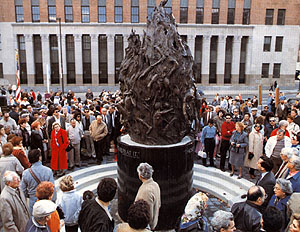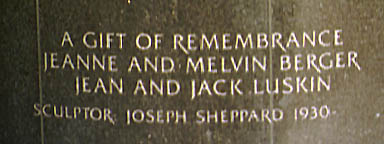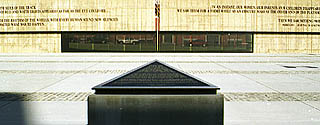
|
Alvin Fisher’s students in his ninth grade Hebrew class at Oheb Shalom Congregation told him that they did not believe that the Holocaust ever happened. Thus was the beginning of Mr. Fisher’s crusade to have a memorial to Holocaust victims constructed in his own city of Baltimore. The Baltimore Jewish Council, in 1976, adopted the project to construct the major monument to Holocaust victims. Ruth Hurwitz, Associate Director, supervised the effort. A one acre site on a busy street in downtown Baltimore was selected. The original memorial, designed by Donald Kann of Kann and Associates and Arthur Valk of Valk Design Associates, was constructed in 1980 for a cost of $300,000. The memorial had three parts; a large grassy mound planted with trees, two 80 by 19 feet cantilevered blocks of bleached, gray-white concrete which were deliberately featureless, cold and brutal and a grassy mall behind the blocks. On one wall was a granite inscription consecrating the memorial to the victims of the Holocaust and listing the 32 camps where they died. |
|
 |
In 1987, Jean and Melvin Burger, and Jean and Jack Luskin commissioned the internationally renowned artist Joseph Sheppard to produce a sculpture for the memorial. |
|
In 1988, the sculpture was dedicated in the memory of Kristallnacht, Night of Broken Glass, which in 1938 the Nazis destroyed Jewish homes, shops and synagogues. A quotation from the philosopher and author George Santayana, "Those who do not remember the past are destined to repeat it" is inscribed around the base of the sculpture. |
 |
|
In 1995, the Baltimore Jewish Council, Rabbi Joel Ziaman, president, agreed to support a redesigned memorial. The original one had substantially deteriorated because it provided a location for activities inappropriate for the memorial. Dr. Arthur C. Abramson, Executive Director, supervised the effort to replace the memorial while leaving the sculpture in place. Architect Jonathan Fishman of Richter, Cornbrooks and Gribble was selected to provide guidance in defining the memorial themes and producing an appropriate architectural design. His description of the theme "Our notion was to conceive the site as an abandoned rail yard. The idea was to evoke a sense of vacancy, an image of abandonment." Holocaust author Dr. Deborah Lipstadt was commissioned to write perspective message to be placed on a plaque. |
|
 |
In 1997 the Baltimore Jewish Council, Myrna Cardin president, dedicated the redesigned memorial. Several survivors of the concentration camps were present for the dedication. A verbal picture of the site, from which images can be viewed, is found on the description page. The adjacent Baltimore City Community College, who owns the land that the memorial sits on, is the home of a Holocaust resource center. |